Fantasy films are films with fantastic themes, usually involving magic, supernatural events, or exotic fantasy worlds. The genre is considered to be distinct from science fiction film and horror film, although the genres do overlap.
Contents |
Genre definition
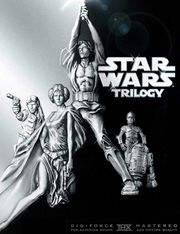 Some critics classify the Star Wars films
as Science Fantasy rather than Science Fiction.
Note, for example, the similarites in
composition of this image to that of Conan
the Barbarian below.
Some critics classify the Star Wars films
as Science Fantasy rather than Science Fiction.
Note, for example, the similarites in
composition of this image to that of Conan
the Barbarian below.
The boundaries of the fantasy literary genre are not well-defined, and the same is therefore true for the film genre as well. Categorizing a movie as fantasy may thus require an examination of the themes, narrative approach and other structural elements of the film.
For example, much about the Star Wars saga suggests fantasy, yet it has the feel of science fiction, whereas much about Time Bandits (1981) suggests science fiction, yet it has the feel of fantasy. Some film critics borrow the literary term Science Fantasy to describe such hybrids of the two genres.
Animated films featuring talking non-human animals and other fantastic elements are not always classified as fantasy, particularly when they are intended for children. Bambi, for example, is not fantasy, nor is 1995's Toy Story, though the latter is probably closer to fantasy than the former. The Secret of NIMH from 1982, however, may be considered to be a fantasy film because there is actual magic involved.
Other children's movies, such as Walt Disney's 1937 classic Snow White and the Seven Dwarfs are also difficult to categorize. Snow White features a medieval setting, dwarven characters, the use of sorcery, and other tropes common to fantasy. Yet many fans of the genre do not believe such movies qualify as fantasy, placing them in instead in a separate fairy tale genre.
Superhero films also fulfill the requirements of the fantasy or science fiction genres but are often considered to be a separate genre. Some critics, however, classify superhero literature and film as a subgenre of fantasy (Superhero Fantasy) rather than as an entirely separate category.
Films that rely on magic primarily as a gimmick, such the 1976 film Freaky Friday and its 2003 re-make in which a mother and daughter magically switch bodies, may technically qualify as fantasy but are nevertheless not generally considered part of the genre.
Surrealist film also describes the fantastic, but it dispenses with genre narrative conventions and is usually thought of as a separate category. Finally, many Martial arts films feature medieval settings and incorporate elements of the fantastic (see for example Crouching Tiger, Hidden Dragon), but fans of such films do not agree if they should also be considered examples of the fantasy genre.
Subgenres
Several sub-categories of fantasy films can be identified, although the delineations between these subgenres, much as in fantasy literature, are somewhat fluid.
The most common fantasy subgenres depicted in movies are High Fantasy and Sword and Sorcery. Both categories typically employ quasi-medieval settings, wizards, magical creatures and other elements commonly associated with fantasy stories.
High Fantasy films tend to feature a more richly developed fantasy world, and may also be more character-oriented or thematically complex. Often, they feature a hero of humble origins and a clear distinction between good and evil set against each other in an epic struggle. Many scholars cite J. R. R. Tolkien's Lord of the Rings trilogy as the prototypical modern example of High Fantasy in literature, and the recent Peter Jackson film adaptation of the books is a good example of the High Fantasy subgenre on the silver screen.
 Conan the Barbarian (1982), a typical
Sword and Sorcery film
Conan the Barbarian (1982), a typical
Sword and Sorcery film
Sword and Sorcery movies tend to be more plot-driven than high fantasy and focus heavily on action sequences, often pitting a physically powerful but unsophisticated warrior against an evil wizard or other supernaturally-endowed enemy. Although Sword and Sorcery films sometimes describe an epic battle between good and evil similar to those found in many High Fantasy movies, they may alternately present the hero as having more immediate motivations, such as the need to protect a vulnerable maiden or village, or even being driven by the desire for vengeance.
The 1982 film adaptation of Robert E. Howard's Conan the Barbarian, for example, is a personal (non-epic) story concerning the hero's quest for revenge and his efforts to thwart a single megalomaniac -- while saving a beautiful princess in the process. Some critics refer to such films by the term Sword and Sandal rather than Sword and Sorcery, although others would maintain that the Sword and Sandal label should be reserved only for the subset of fantasy films set in ancient times on the planet Earth, and still others would broaden the term to encompass films that have no fantastic elements whatsoever. To some, the term Sword and Sandal has pejorative connotations, designating a film with a low-quality script, bad acting and poor production values.
Another important sub-genre of fantasy films that has become more popular in recent years is Contemporary Fantasy. Such films feature magical effects or supernatural occurrences happening in the "real" world of today. The most prominent example in the early 21st century is the Harry Potter series of films adapted from the novels of J. K. Rowling.
Fantasy films set in the afterlife, called Bangsian Fantasy, are less common, although films such as the 1991 Albert Brooks comedy Defending Your Life would likely qualify. Other uncommon subgenres include Historical Fantasy and Romantic Fantasy, although 2003's Pirates of the Caribbean: The Curse of the Black Pearl successfully incorporated elements of both.
As noted above, superhero movies and fairy tale films might each be considered subgenres of fantasy films, although most would classify them as altogether separate movie genres.
Fantasy movies and the film industry
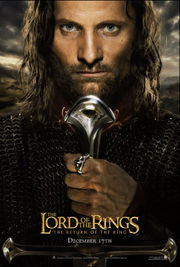 The Lord of the Rings: The Return of the King,
winner of the 2004 Academy Award for Best
Picture
The Lord of the Rings: The Return of the King,
winner of the 2004 Academy Award for Best
Picture
As a cinematic genre, fantasy has traditionally not been regarded as highly as the related genre of science fiction film. Undoubtedly, the fact that until recently fantasy films often suffered from the "Sword and Sandal" afflictions of inferior production values, over-the-top acting and decidedly poor special effects was a significant factor in fantasy film's low regard. Even 1981's Raiders of the Lost Ark, which did much to improve the genre's reputation in public as well critical circles, was still derided in some quarters because of its comic book-like action sequences and tongue in cheek comedy.
Since the late 1990s, however, the genre has gained new respectability, driven principally by the successful adaptations of J.R.R. Tolkien's The Lord of the Rings and J.K. Rowling's Harry Potter series. Jackson's The Lord of the Rings trilogy is particularly notable due to its ambitious scope, serious tone and thematic complexity. These pictures achieved phenomenal commercial and critical success, and the third installment of the trilogy became the first fantasy film ever to win the Academy Award for Best Picture.
Following the success of these ventures, Hollywood studios have greenlighted additional big-budget productions in the genre. These have included a successful adaptation of the first book in C. S. Lewis' The Chronicles of Narnia series as well as upcoming adaptations of Susan Cooper's The Dark is Rising and the cult novel Eragon.
Fantasy movies in recent years, such as 2005's Narnia adaptation, have most often been released in November and December. This is in contrast to science fiction films, which are often released during the summer.
History
Fantasy films have a history almost as old as the medium itself. Fantasy offerings were released only sporadically until the 1980s, however, when high-tech filmmaking techniques and increased audience interest caused the genre to flourish.
Early Years
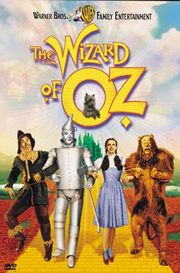 The Wizard of Oz (1939), a fantasy film
classic
The Wizard of Oz (1939), a fantasy film
classic
In the era of silent film the outstanding fantasy films were Douglas Fairbanks' The Thief of Bagdad (1924) and Fritz Lang's Die Nibelungin (1925). Following the advent of sound films, audiences of all ages embraced what is surely the best loved fantasy film of all time, 1939's The Wizard of Oz. Also notable of the era, the iconic 1933 film King Kong is not a pure example of the genre, but borrows heavily from the Lost World subgenre of fantasy fiction. And Frank Capra's 1937 picture Lost Horizon transported audiences to the Himalayan fantasy kingdom of Shangri-La, where the residents magically never age.
1940s
The 1940s then saw several full color fantasy films produced by Alexander Korda, including The Thief of Bagdad (1940) and Jungle Book (1942). In 1946, Jean Cocteau's classic adaptation of Beauty and the Beast won praise for its surreal elements and for transcending the boundaries of the fairy tale genre. Sinbad the Sailor (1947), starring Douglas Fairbanks, Jr., has the feel of a fantasy film though it does not actually have any fantastic elements. Conversely, It's a Wonderful Life and A Matter of Life and Death, both from 1946, do not feel like fantasy films yet both feature supernatural elements and the latter movie could reasonably be cited as an example of Bangsian fantasy.
In addition, several other pictures featuring supernatural encounters and aspects of Bangsian fantasy were produced in the 1940s. These include The Devil and Daniel Webster and Here Comes Mr. Jordan from 1941, Heaven Can Wait and the musical Cabin in the Sky from 1943, and 1947's The Ghost and Mrs. Muir. But because these movies do not feature elements common to high fantasy or sword and sorcery pictures, some critics do not consider them to be examples of the fantasy genre.
1950s
In the 1950's there were only two major fantasy films, Darby O'Gill and the Little People and The 5000 Fingers of Dr. T, the latter penned by Dr. Seuss. Jean Cocteau's Orphic Trilogy, begun in 1930 and completed in 1959, is based on Greek mythology and could be classified either as fantasy or surrealist film, depending on how the boundaries between these genres are drawn.
Three other notable pictures from the 1950s that feature fantastic elements and are sometimes classified as fantasy are: Harvey (1950), featuring a púca of Celtic mythology; Scrooge, the 1951 adaptation of Charles Dickens' A Christmas Carol; and Ingmar Bergman's 1957 masterpiece, The Seventh Seal.
There were also a number of low budget fantasies produced in the 1950s, typically based on Greek or Arabian legend. The most notable of these is probably 1958's The 7th Voyage of Sinbad, featuring special effects by Ray Harryhausen.
1960s and 1970s
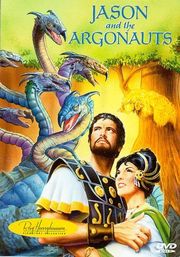 Jason and the Argonauts (1963), featuring
special effects by Ray Harryhousen
Jason and the Argonauts (1963), featuring
special effects by Ray Harryhousen
Harryhousen worked on a series of fantasy films in the 1960s, most importantly Jason and the Argonauts (1963). Many critics have identified this film as Harryhousen's masterwork for its stop-motion animated statues, skeletons, harpies, hydra, and other mythological creatures. Other Harryhousen fantasy and science fantasy collaborations from the decade include the 1961 adaptation of Jules Verne's Mysterious Island, the critically panned One Million Years B.C. starring Raquel Welch, and The Valley of Gwangi (1969).
Otherwise, the 1960's were almost entirely devoid of fantasy films. The fantasy picture 7 Faces of Dr. Lao, in which Tony Randall portrayed several characters from Greek mythology, was released in 1964. But the 1967 adaptation of the Broadway musical Camelot removed most of the fantasy elements from T. H. White's classic The Once and Future King, on which the musical had been based.
Fantasy elements of Arthurian legend were again featured, albiet absurdly, in 1975's Monty Python and the Holy Grail. Harryhousen also returned to the silver screen in the 1970s with two additional Sinbad fantasies, The Golden Voyage of Sinbad (1974) and Sinbad and the Eye of the Tiger (1977). Some would consider 1977's Oh God!, starring George Burns to be a fantasy film, and Heaven Can Wait (1978) was a successful Bangsian fantasy remake of 1941's Here Comes Mr. Jordan (not 1943's Heaven Can Wait).
A few low budget "Lost World" pictures were made in the 1970s, such as 1975's The Land That Time Forgot. And the animated movie Wizards (1977) had limited success at the box office but achieved status as a cult film. Otherwise, the fantasy genre was again often absent from theaters in this decade, although some would classify 1971's Bedknobs and Broomsticks and Willy Wonka & the Chocolate Factory as fantasy pictures.
With the historical fantasy Raiders of the Lost Ark in 1981, however, a fantasy explosion began which continues into the Twenty-first Century.
1980
- Hawk the Slayer
1981
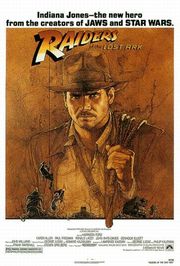 Raiders of the Lost Ark (1981), an
example of the Historical Fantasy sub-genre, was
a huge commercial success and generated renewed
interest in fantasy films.
Raiders of the Lost Ark (1981), an
example of the Historical Fantasy sub-genre, was
a huge commercial success and generated renewed
interest in fantasy films.
Raiders of the Lost Ark
Clash of the Titans
Dragonslayer
Excalibur
Heavy Metal
1982
The Beastmaster
Conan the Barbarian
Ator the Fighting Eagle
The Dark Crystal
Poltergeist
The Sword and the Sorcerer
1983
Deathstalker
Krull
1984
Conan the Destroyer
The Company of Wolves
Ghostbusters
Indiana Jones and the Temple of Doom
The NeverEnding Story
1985
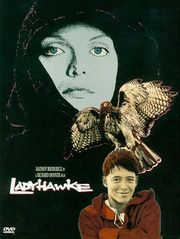 As fantasy film's box office draw increased, so
did its star power. 1985's Ladyhawke, for
example, starred
Matthew Broderick, Michelle Pfeiffer and Rutger
Hauer.
As fantasy film's box office draw increased, so
did its star power. 1985's Ladyhawke, for
example, starred
Matthew Broderick, Michelle Pfeiffer and Rutger
Hauer.
The Black Cauldron
Ladyhawke
Legend
1986
Highlander
Labyrinth
1987
The Princess Bride
Masters of the Universe
The Barbarians aka The Barbarian Brothers
1988
The Adventures of Baron Munchausen
Scrooged
Willow
1989
- Indiana Jones and the Last Crusade
1990s
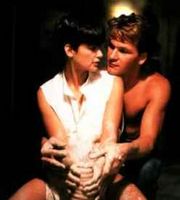 Patrick Swayze and Demi Moore in 1990's Ghost, a popular
example of the Romantic Fantasy subgenre
Patrick Swayze and Demi Moore in 1990's Ghost, a popular
example of the Romantic Fantasy subgenre
The Blair Witch Project
Death Becomes Her
Dragonheart
Edward Scissorhands
Indian in the Cupboard, The
Ghost
Ghost in the Machine
Green Mile, The
Groundhog Day
Jumanji
Kull the Conqueror
Meet Joe Black
Photographing Fairies
Princess Mononoke (Mononoke Hime)
Sixth Sense, The
The Witches (film)
X-Files, The
2000s
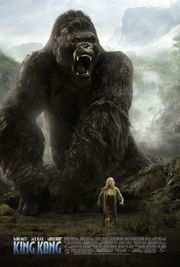 Peter Jackson's 2005 remake of King Kong
is an example of the "Lost World" subgenre of
fantasy film and was the seventh film to feature
the iconic giant ape.
Peter Jackson's 2005 remake of King Kong
is an example of the "Lost World" subgenre of
fantasy film and was the seventh film to feature
the iconic giant ape.
Big Fish
The Chronicles of Narnia: The Lion, the Witch and the Wardrobe
Crouching Tiger, Hidden Dragon
The Harry Potter films
Holes
Hexer (Wiedźmin)
King Kong
The Lord of the Rings film trilogy
Pirates of the Caribbean: The Curse of the Black Pearl
Unbreakable
Van Helsing
Additional examples
Ancanar (not yet released)
Eragon (not yet released)
Alice in Wonderland (1933 film) - 1933 version with Charlotte Henry, W.C. Fields, Cary Grant
Alice in Wonderland (1951 film) - 1951 Disney animated film
The Last Unicorn (not yet released)
See also
External links
Categories: Film genres




 216.73.216.81
216.73.216.81 User Stats:
User Stats:
 Today: 0
Today: 0 Yesterday: 0
Yesterday: 0 This Month: 0
This Month: 0 This Year: 0
This Year: 0 Total Users: 117
Total Users: 117 New Members:
New Members:
 216.73.xxx.xx
216.73.xxx.xx
 Server Time:
Server Time: